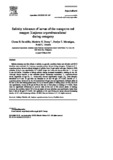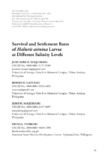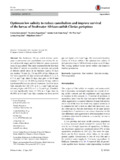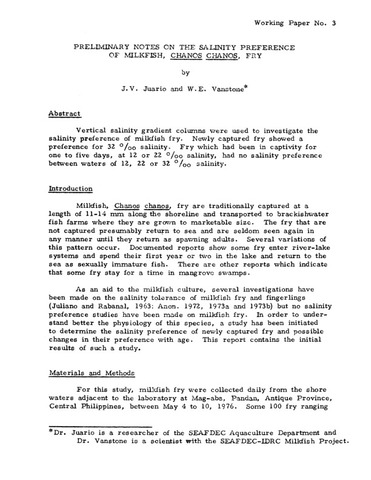Salinity tolerance of larvae of the mangrove red snapper (Lutjanus argentimaculatus) during ontogeny

Associated URL
www.vliz.beDate
2000Page views
388Metadata
Show full item recordCited times in Scopus
Share
Abstract
Salinity tolerance and the effects of salinity on growth, condition factor and chloride cell (CC) densities were evaluated for Lutjanus argentimaculatus larvae during ontogeny. Tolerance of L. argentimaculatus larvae to abrupt changes of salinity from 32 ppt varied with age. Periods to 50% mortality (LT50) were significantly (P<0.05) longer for 0-day-old larvae than for 7-, 14- and 21-day-old larvae. Tolerance of abrupt salinity change increased remarkably, starting on day 28. Although abrupt transfer to test salinities caused substantial mortalities, L. argentimaculatus larvae, regardless of age (0-, 7-, 14-day-old), showed significantly longer LT50 when abruptly transferred to 8 and 16 ppt than for transfers to 24 and 40 ppt (P<0.05). Growth of L. argentimaculatus larvae at 16, 24, 32 (control) and 40 ppt was not significantly different either at the end of the first rearing phase (days 0–21) or second phase of rearing (days 22–50). Survival was significantly lowest at 40 ppt (4.3%) at the end of first phase of rearing (P<0.05). There were no significant differences in survival rates at the end of the second phase of rearing; however, the condition factor (K) of larvae reared at lower salinities was significantly higher than that of fish at 40 ppt (P<0.05). Gill epithelia of 42- and 50-day-old larvae showed increasing density of CC with increasing salinity.
Suggested Citation
Estudillo, C. B., Duray, M. N., Marasigan, E. T., & Emata, A. C. (2000). Salinity tolerance of larvae of the mangrove red snapper (Lutjanus argentimaculatus) during ontogeny. Aquaculture , 190(1-2), 155-167. https://doi.org/10.1016/S0044-8486(00)00390-2
Subject
Collections
- AQD Journal Articles [1240]
Related items
Showing items related by title, author, creator and subject.
-
Survival and settlement rates of Haliotis asinina larvae at different salinity levels
Maquirang, Jean Rose H.; Caturao, Romeo D.; Maquirang, Jessy H.; Pedroso, Fiona L. (IAMURE Multidisciplinary Research, 2013)The study was conducted to determine the optimum salinity levels (24 ppt, 28 ppt, 32 ppt, 36 ppt and 40 ppt) for the survival and settlement rates of H. asinina in a complete randomized design with three replicates each. ... -
Optimum low salinity to reduce cannibalism and improve survival of the larvae of freshwater African catfish Clarias gariepinus
Kawamura, Gunzo; Bagarinao, Teodora; Yong, Annita Seok Kian; Sao, Pei Wen; Lim, Leong Seng; Senoo, Shigeharu (Springer Verlag, 2017)The freshwater African catfish Clarias gariepinus is carnivorous and cannibalistic even during the larval and juvenile stages and this behavior causes economic losses in aquaculture. This study examined for the first time ... -
Preliminary notes on the salinity preference of milkfish, Chanos chanos, fry
Juario, Jesus V.; Vanstone, William E. (Aquaculture Department, Southeast Asian Fisheries Development Center, 1976)Vertical salinity gradient columns were used to investigate the salinity preference of milkfish fry. Newly captured fry showed a preference for 32‰ salinity. Fry which had been in captivity for one to five days, at 12 or ...




